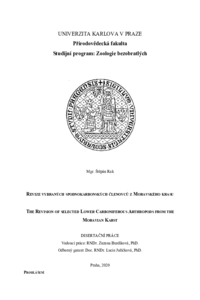Revize vybraných spodnokarbonských členovců z Moravského krasu
The Revision of selected Lower Carboniferous Arthropods from the Moravian Karst
dizertační práce (OBHÁJENO)

Zobrazit/
Trvalý odkaz
http://hdl.handle.net/20.500.11956/120854Identifikátory
SIS: 216201
Kolekce
- Kvalifikační práce [19614]
Autor
Vedoucí práce
Konzultant práce
Juřičková, Lucie
Oponent práce
Mergl, Michal
Hyžný, Matúš
Fakulta / součást
Přírodovědecká fakulta
Obor
-
Katedra / ústav / klinika
Katedra zoologie
Datum obhajoby
10. 9. 2020
Nakladatel
Univerzita Karlova, Přírodovědecká fakultaJazyk
Čeština
Známka
Prospěl/a
Klíčová slova (česky)
trilobitove asociace, thylacocephala, ekologie, pokrocile mikroskopicke techniky, spodni karbonKlíčová slova (anglicky)
trilobite association, thylacocephala, ecology, advanced microscopic techniques, Lower CarboniferousV disertační práci se věnuji revizi vybraných skupin spodnokarbonských členovců z Moravského krasu: trilobitům a thylacocephalům, jejich systematice, autekologii a taxonomii. V první části práce analyzuji výskyt atheloptického trilobitového společenstva v okolí obce Březina v Moravském krasu, společenstvo srovnávám s podobnými výskyty ze světa. Je stanovena nová trilobitová asociace. V druhé části je popsán první výskyt karbonského thylacocephala mimo území USA. Deatilně je studována jeho specifická struktura karapaxu a na jejím základě stanoven nový druh Paraconcavicaris viktoryni (Broda et al., 2020).
In my dissertation thesis I made a revision of two selected groups of Lower Carboniferous arthropds from the Moravian Karst: trilobites and thylacocephalans. I studied their systematics, autecology as well as taxonomy. In the first part I mapped an occurrence of an atheloptic trilobite association in the Březina village vicinity. Based on a study the new trilobite association is erected. The second part is focused on the very first discovery of Lower Carboniferous thylacocephalan outside of US. Its specific carapace structure is studied. New species Paraconcavicaris viktoryni (Broda et al. 2020) is determined and compared to known species.
